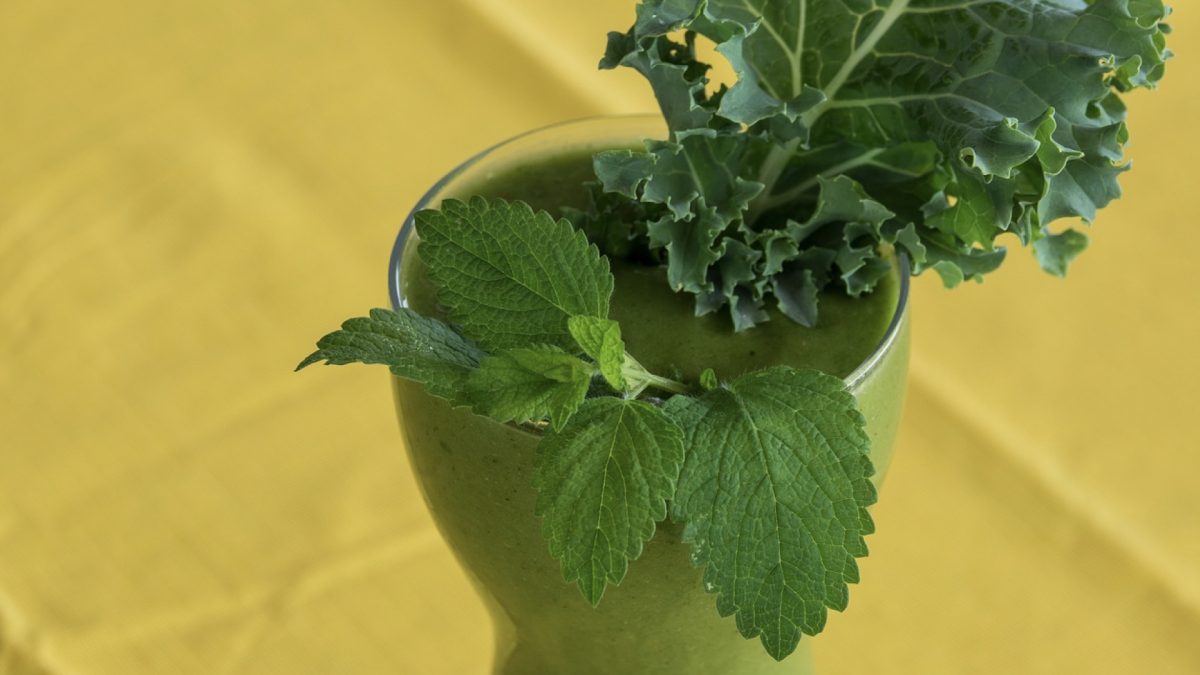Fruits and vegetables are the most nutrient-dense foods on the planet, and dark green leafy vegetables lead the pack. Each of the top five so-called powerhouse fruits and vegetables were greens. If we blend them up in a smoothie (or soup or sauce), we’re taking the food with the most nutrition and breaking all the cells to dump that nutrition into our bloodstream. Chewing is good, but blending is better in terms of digestive efficiency and nutrient absorption.
But if we take in all that nutrition and none makes it down to our colon might we be starving our microbial selves? The reason intact grains, beans, and nuts are better than bread, hummus, and nut butters is that no matter how well we chew, intact food particles make it down to your colon where they can offer a smorgasbord for our good bacteria. If our grains, beans, and nuts are finely ground up into flour or paste before we eat it, we may be leaving our gut flora high and dry. Would the same be true for fruits and vegetables?
There are special classes of phytonutrients in fruits and vegetables that appear to protect against colon cancer. They can escape digestion and absorption in our stomach and small intestine, and end up in our colon to act as prebiotics. No matter how much we chew, they stay attached to the fiber. But if we use a blender, might we prematurely detach these nutrients? No. Even if you blend in a high-speed blender for five minutes, the phytonutrients remain bound to the fiber for transport down to your colon bacteria. You can do smoothie experiments on people with ileostomy bags that drain the contents of the small intestine and show that most of the polyphenol phytonutrients make it out intact; so, we don’t have to worry we may be robbing Peter to pay Paul when we blend fruits and vegetables. Is there any downside to smoothies, then?
Just as smaller particle size may improve digestive efficiency and gastrointestinal absorption of nutrients from fruits and vegetables, the same may be true for grains. There is, however, a concern that this could boost starch availability and cause a blood sugar spike. In my video Are Green Smoothies Bad for You?, I show you the rise and fall of blood sugar and insulin over four hours after eating a half-cup of brown rice compared with ground brown rice flour (kind of like a cream of brown rice hot cereal). Consuming brown rice flour gives you twice the blood sugar and twice the insulin spike compared to eating the rice intact. Same amount of food, just in a different form. This is why intact whole grains are better than even whole grain flour products.
Simply chewing really well can boost the glycemic and insulin response. If you chew rice really well compared to chewing it normally, the smaller rice particles empty out of your stomach faster, producing greater blood sugar and insulin responses. It’s ironic that there were health crusaders pushing people to chew more to digest their food better, but if what you’re chewing is a five cheese pizza, maybe it’s better not to digest so well. Believe it or not, some have even suggested that diabetics and obese persons should not chew their food so much. But, swallowing diced food without chewing would not only reduce the pleasure of eating—people could choke! Despite this, they suggest it could be a simple way to “allow patients to reduce blood glucose [sugar] levels without fundamentally altering their diets and may thus prove more acceptable” than having to do the unthinkable—just eat high fiber foods like beans, which have been shown to blunt blood sugar spikes.
What about blended beans like hummus? Unlike grains, blending legumes doesn’t affect their glycemic response. So, let’s circle back to the smoothie question: Is fruit more like grains or more like beans? If you liquefy fruit in a blender to make a smoothie, do you risk spiking your blood sugar too high? To find out, watch my Green Smoothies: What Does the Science Say? video.
My general take on beans is simple: the more beans, the better—however you get them. For more information, watch my videos Beans and the Second Meal Effect, The Hispanic Paradox: Why Do Latinos Live Longer?, and Canned Beans or Cooked Beans?.
Want more on smoothies? Here it is:
- Are Green Smoothies Good for You?
- Liquid Calories: Do Smoothies Lead to Weight Gain?
- Testing the Dietary Compensation Theory
- The Downside of Green Smoothies
In health,
Michael Greger, M.D.
PS: If you haven’t yet, you can subscribe to my free videos here and watch my live, year-in-review presentations:
- 2012: Uprooting the Leading Causes of Death
- 2013: More Than an Apple a Day
- 2014: From Table to Able: Combating Disabling Diseases with Food
- 2015: Food as Medicine: Preventing and Treating the Most Dreaded Diseases with Diet
- 2016: How Not To Die: The Role of Diet in Preventing, Arresting, and Reversing Our Top 15 Killers
